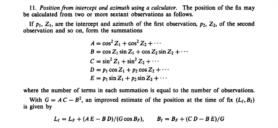
NavList:
A Community Devoted to the Preservation and Practice of Celestial Navigation and Other Methods of Traditional Wayfinding
Fw: Re: A simple three-body fix puzzle
From: George Huxtable
Date: 2010 Dec 9, 10:15 -0000
From: George Huxtable
Date: 2010 Dec 9, 10:15 -0000
Frank wrote- "I'm also attaching the scan of the relevant paragraph. Note that in the last line, L and B with subscripts refer to longitude and latitude, but all we need here is the difference in these in miles which is given by (AE-BD)/G and (CD-BE)/G". =============== No, not in miles. Frank has taken the result of that last step in the iteration, which gave a difference in degrees of long and lat, and omitted the cos Bf term in the denominator of the long to provide the longitudinal distance instead. But those distances, in lat and long, being converted degrees, will be in units of 60 miles, not of miles. The Almanac doesn't explain well, and Frank hasn't either, that this is just one step in an iteration, which starts from a guessed initial position, such as the DR position. The next step is to test whether the resulting change in position is outside some preset limit, and the Almanac suggests 20 miles. Depending on how close the DR position was, a single iteration may well suffice. It depends. If another iteration is called for (and this is the bit that isn't explained well) then all the azimuths and intercepts have to be recalculated, using the new values of assumed long and lat, and the summations repeated using those new values, and these are used to provide a better estimate still. Convergence is usually rapid. If only two observations are being worked, there will of course be two solutions to the problem.. If you happened to choose an initial position that was on the great circle of points that are equidistant between those two solutions, the program is likely to get into a mess, not knowing which way to turn, and infinities may crop up. Otherwise, the algorithm seems to find its way to whichever solution is in the same hemisphere as the initial position was placed in, in relation to that equidistant great circle. Having found one solution from some chosen starting point, you can then be sure to flush out its partner by starting from the antipode. The same procedure is described also in the publication by the British Nautical Almanac Office, "AstronavPC and compact data 2001-2005", which is the edition that I have. It then goes on to deduce procedures for obtaining the error-ellipse parameters, but there are errors, which have been discussed here before.. I don't know whether later editions have put things right. I hope so. George. contact George Huxtable, at george@hux.me.uk or at +44 1865 820222 (from UK, 01865 820222) or at 1 Sandy Lane, Southmoor, Abingdon, Oxon OX13 5HX, UK.







